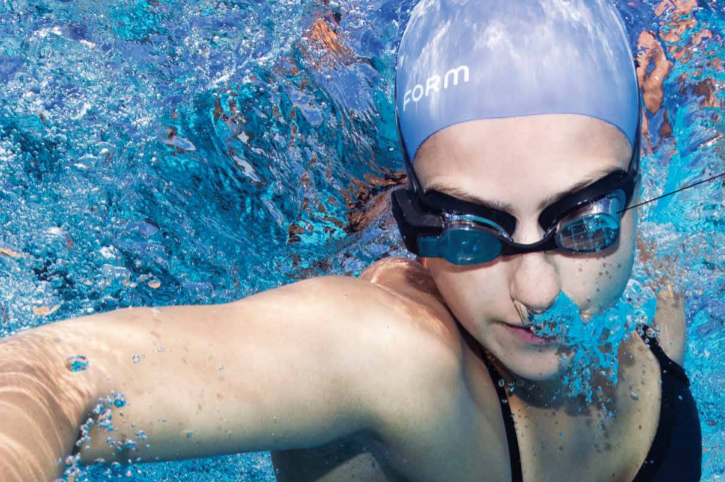
In recent years, tech gadgets that give real-time access to performance metrics have transformed how runners and cyclists train.
But for swimmers, things haven’t gone as swimmingly—largely because taking time to glance at a wrist-worn device mid-swim impedes performance.
That’s why a new pair of smart swim goggles created by Canadian startup FORM are poised to make a huge splash.
The FORM goggles look and feel similar to a regular pair of swim goggles but integrate a miniaturized computer that tracks and displays real-time performance data on the goggles’ see-through lens. Swimmers can see key metrics like split times, distance, and stroke rate—without interrupting their flow in the slightest.
Aqua-man
The goggles are the brainchild of FORM founder and CEO Dan Eisenhardt, who—before starting his career as a sports technology entrepreneur—swam competitively for 14 years in both his native Denmark and America.
“I ended up becoming a mid- to long-distance swimmer,” says Eisenhardt, “so I really felt the pain of not having any metrics in real time while I was swimming.”
In 2006, while studying for his MBA, Eisenhardt came up with the idea for swim goggles with a headup display (a transparent display that doesn’t require users to move their head or change their field of vision in order to view the data being displayed). But technology wasn’t quite at the point where developing the goggles was feasible. Instead of diving in, Eisenhardt founded a company called Recon Instruments that built smart eyewear for other sports, including skiing, cycling, and running.
Eisenhardt returned to his swim goggle vision after Intel acquired Recon in 2015. By then, form factors and power requirements for wearable computing had decreased enough to make his idea achievable and affordable for consumers. In 2016, he founded FORM and recruited some former Recon engineers to apply their know-how to the pool environment.
In the Swim of Things
These are swimming metrics that FORM goggles can display.
Timer: Duration of the current workout or interval
Rest timer: Duration of the current rest period
Split time: Time taken to swim the previous length
Interval finish time: Time taken to swim the current interval
Distance: Distance swum in meters or yards
Pace per 100: Average time to swim 100 meters or yards
Pace per 50: Average time to swim 50 meters or yards
Stroke rate: Average strokes per minute
Stroke count: Number of strokes for the previous length
Distance per stroke: Average distance per stroke in meters or yards
Length counter: Number of lengths swum
Calories: Calories burned
Total time: Total duration of the current workout, including rest periods
Swimming Upstream
The nearly three-year road to perfecting the goggles was fraught with challenges. In addition to overcoming the elements of water and chlorine, the team had to essentially teach the device to accurately detect movement and rest.
“The whole engine behind the swim goggles is based on AI and machine learning,” says Eisenhardt. Data collected by the goggles’ sensors, accelerometer, and gyroscope is fed into a machinelearning algorithm. “To be able to train that algorithm,” says Eisenhardt, “you have to spend a lot of time with a lot of swimmers of different skill levels.”
Eisenhardt invited triathletes, fitness swimmers, and several Olympic swimmers—including Scott Dickens, who now serves as FORM’s director of strategic partnerships—to validate the goggles. After years of fine-tuning, the result is that “you just go in the water and [the] automatically detect everything,” Eisenhardt says.
Users can customize exactly which metrics get displayed. For example, competitive swimmers can use the pace clock and track the factors behind speed such as stroke rate, stroke count, and pace per 100 meters. Endurance swimmers can set the goggles to count their lengths and record their total distance and distance per stroke.
Eisenhardt says that “offloading that mental math” is nothing short of revolutionary. “For the first time ever, a swim coach can now give directions to his or her swimmer and be able to empower them to follow that in real time.”
Pooling Resources
The goggles’ data can also be synched with the FORM Swim App, allowing swimmers, coaches, and other members of the FORM community to review and share workouts. “The app is where you really harvest all of the value,” Eisenhardt says, because users can quantify and compare their progress over time, helping them to “set goals, achieve them, and improve performance.”
Eisenhardt is confident that FORM swim goggles will become an indispensable tool for elite athletes and teams, as well as bring together a worldwide community of fitness swimmers. Given that there are more than 27 million active pool swimmers in the US alone, Eisenhardt predicts the team at FORM “will be plenty busy for the foreseeable future.”
Rachel B. Levin is a Los Angeles-based freelance writer covering food, health, and sustainability. Follow her on Instagram: @rachelbethlevin.






























